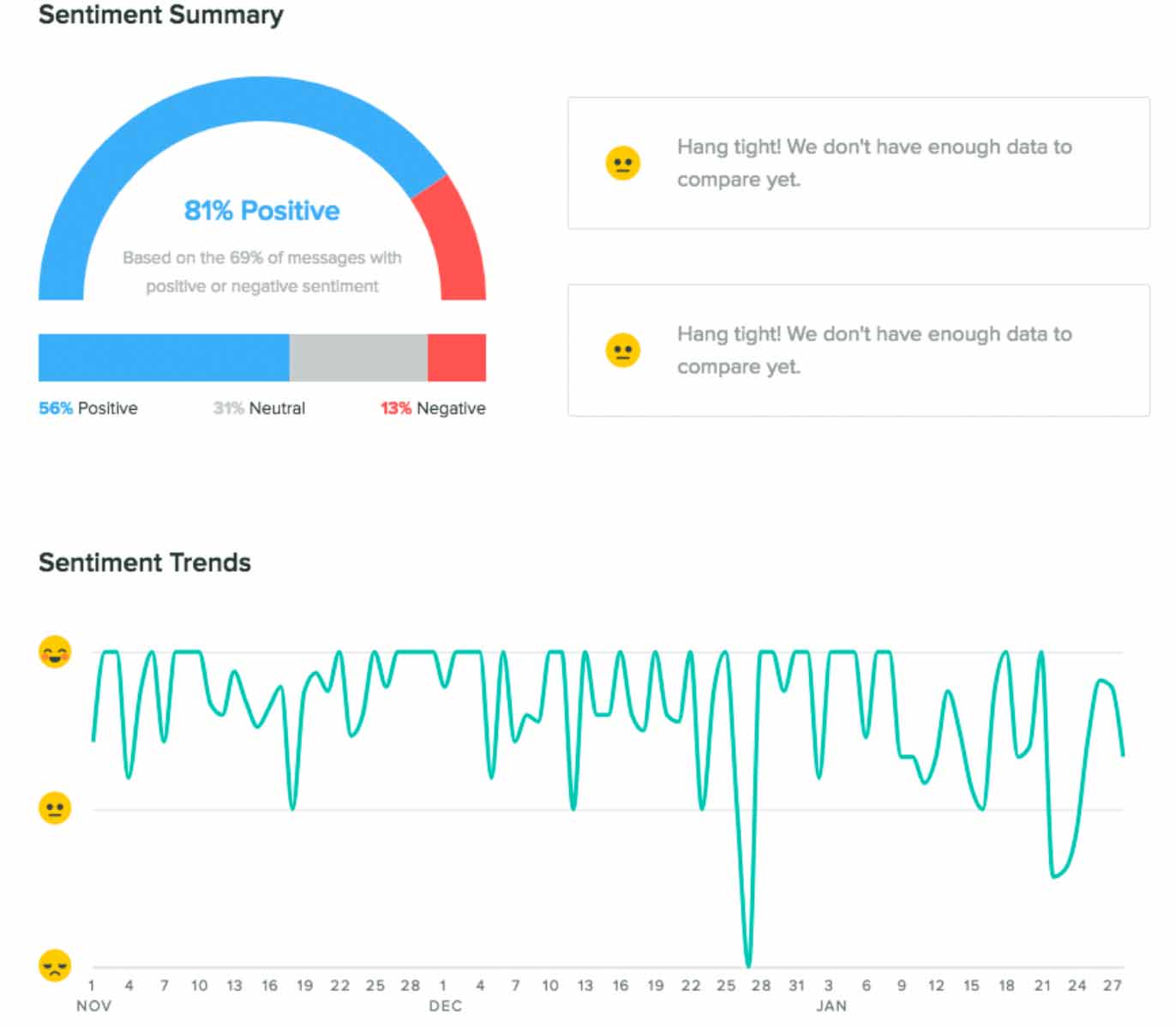What Is Sentiment Analysis? Importance, Brand Building, and Tactics
As the term “sentiment analysis” suggests, a basic goal in sentiment analysis is to classify the polarity of a given text. Sentiment analysis does this by looking at the document, sentence, or entity feature/aspect and assigning it a polarity — positive, negative, or neutral. Beyond polarity, sentiment classification, however, has even more advanced possibilities. For example, it can assign emotional states to texts such as “angry,” “sad,” and “happy.”
Sentiment analysis provides insights into people’s opinions and emotions about your brand, product, or service online. It uses natural language processing (NLP) and machine learning to quickly identify the tone of text, video, or images, which can help brands identify and react to negative reviews, articles, or other mentions.
What sentiment analysis is used for
The insights gained through sentiment analysis provide an efficient way to monitor and improve your online reputation. Access to sentiment information at scale means you can better maintain the pulse of your online community – what people think of you and your competitors. This enables you to strategize more effectively and deal with problems before they escalate.
This blog will cover sentiment analysis, how it works, and what it means for your business and its reputation.
Sections
- What is sentiment analysis?
- How to use sentiment analysis for brand building
- Why sentiment analysis is important
- How sentiment analysis can improve your online reputation
What is sentiment analysis?
Sentiment analysis often uses artificial intelligence to identify the emotional tone of an online mention, such as social media posts. It’s important because it can be used to monitor people’s feelings and opinions about your brand. You can track and react to what’s working, what’s not, and what differentiates you from your competitors.
If your overall sentiment is positive, your brand will flourish. You can expect to see increased sales, higher stock valuations, more qualified employment applications, and decreased turnover. It is also a good indicator of your overall reputation.
People are quick to share their opinions online – sometimes too quickly. Tweets can express just about every emotion possible: whether someone is happy, sad, angry, disappointed, surprised, proud… the list goes on. A good sentiment analysis tool will be able to mine posts for various emotions and tones and sort them into high-level categories:
- Positive sentiment: People like your product or brand. They’re using words like “love,” “best,” “highly recommend,” etc. to describe their experience and are likely to share and promote you to their friends and followers.

- Neutral sentiment: Neither good nor bad, neutral posts aren’t helping your reputation, but they aren’t hurting it either. People are using words like “okay” or “adequate” to describe you. There is some opportunity here to engage with people who are sharing neutral posts about your brand. They might just need a little extra attention to form a more positive opinion.
- Negative sentiment: People are dissatisfied with your brand. They’re describing it with words like “worst,” “never again,” or “hate.” You’ll have to work to improve your sentiment.
How to use sentiment analysis for brand building
Sentiment analysis offers a way to understand how people feel about your brand. There are many ways to analyze online sentiment. You can do some of them on your own, but that becomes difficult or impossible at scale. Fortunately, plenty of tools are available to monitor and report on your online sentiment without requiring you to analyze every tweet yourself.
Ways to analyze sentiment
Here are some ways you can analyze the online sentiment of your company:
- Search engine research: This you can do by yourself. Perform a Google search using your company name plus target keywords to get an idea of the mood surrounding your company.
- In-depth research: Dive deeper to check out what is being said about you in blogs, articles, and reviews. Again, you can do this manually.
- Social research: Social listening can monitor and analyze what is being said about your brand on social media. Tools work best for this.
- Competitor research: Compare your company with other industry players to gain insights into what’s expected and what’s unusual when it comes to corporate sentiment in your industry.
Sentiment analysis tools can measure the overall sentiment of your brand in an automated way because, at a certain point, it becomes impossible for you to manually track all mentions of your brand. Since sentiment analysis tools use complex algorithms and machine learning to determine sentiment, there will always be some caveats to the results. In our experience, sentiment tools make mistakes, so they cannot be completely relied upon at all times. For example:
- Negation, where the “polarity” of words is reversed. For example, “It’ll be the last time he does that.”
- Sarcasm is difficult for sentiment analysis tools to catch all of the time. “He thinks he’s the best thing since sliced bread”.
- Ambiguity, which is a lack of word clarity, can be a problem for analysis tools.
The main types of algorithms used to determine sentiment include:
- Rule-based systems: You manually create the rules for the system by defining which words are positive, negative, or neutral. These types of systems don’t consider how different sequences of word can impact the sentiment and require maintenance over time to adjust for new expressions and vocabulary.
- Automatic systems: This is a more popular approach to sentiment analysis that relies on machine learning techniques to learn from data over time.
- Hybrid systems: Combine both rule-based and automatic systems for more accurate results.
A sentiment analysis report can look something like this one from Sprout Social:

List of tools for sentiment analysis
There are many tools available to measure sentiment. Here are some popular options:
- Brand24
- Sprout Social
- Critical Mention
- Mention
- Parallel Dots
- Hootsuite Insights (UberVu)
- IBM Watson Tone Analyzer
- Brandwatch
- RapidMiner
- Semantria
Other methods for sentiment analysis
More sentiment analysis resources
For more in-depth resources on various sentiment analysis tools, try these articles:
- Talkwalker review of sentiment tools
- Tools to monitor brand health
- Hootsuite guide to social sentiment
Why sentiment analysis is important
Having access to what people say about you online unlocks the ability to connect with your audience on a deeper level, improve your overall marketing strategy, and, most importantly, quickly respond to negative posts to improve your reputation.
Sentiment analysis enables you to:
- Quickly respond to feedback (both negative and positive)
- Develop a more powerful marketing strategy
- Measure the impact of social media efforts
- Form more impactful brand partnerships
- Stay ahead of the competition
- Fast-track growth
How sentiment analysis can improve your online reputation
Understanding your target audience is key to the success of any reputation management strategy. Whether your goal is to gain more control over how you are perceived online or to improve the quality of information that exists out there, sentiment analysis is a powerful tool to have at your disposal.
Once you understand people’s feelings toward your brand, you will be able to develop a targeted reputation management strategy. In reputation management, we can use sentiment analysis techniques beyond the scope of social media. We look at sentiment in the context of search results and visibility. Something with a strongly negative sentiment that is far back in search results is less of a threat than something with a slightly negative sentiment that sits at the top of page one in Google or Bing.
We are conducting sentiment analysis every time we read a post, comment, or review. We determine the tone of the post – usually without even having to think about it – and we react accordingly by responding to the original post, reworking the strategy, etc. Sentiment analysis tools help us to streamline this process and conduct it at scale.
Regardless of the size and scope of your sentiment analysis efforts, it is essential to maintain a pulse on what people are saying about your brand online. The more closely you monitor the feelings and opinions that people have about your brand; the easier it will be to grow and adapt over time.
Sentiment Analysis FAQs
What is sentiment analysis?
Sentiment analysis is a technique used to identify the emotional tone of an online mention of your brand. This includes social media posts, online reviews, and blog articles.
What is sentiment analysis used for?
Sentiment analysis can help brands identify and react to negative reviews, articles, or other mentions. It is used to quickly identify the tone of text, video, or images about your brand.
How can I analyze my company’s online sentiment?
Perform search engine research using your company name and target keywords. Employ social listening techniques to monitor and analyze what is said about your brand on social media. Compare your company with your competitors to gain insights into what’s expected and what’s unusual when it comes to corporate sentiment in your niche.
What are the most popular sentiment analysis tools?
Popular sentiment analysis tools include Brand24, Sprout Social, Critical Mention, Mention, and Parallel Dots.
Why is sentiment analysis important?
Sentiment analysis enables you to respond quickly to feedback (both negative and positive), develop a more powerful marketing strategy, measure the impact of social media efforts, form more impactful brand partnerships, stay ahead of the competition, and fast-track growth.
About the author
Brianne Schaer is a Writer and Editor for Reputation X, an award-winning online reputation management services agency based in California. Brianne has more than seven years of experience creating powerful stories, how-to documentation, SEO articles, and Wikipedia content for brands and individuals. When she’s not battling AI content bots, she is cruising around town in her Karmann Ghia. You can see more of her articles here and here.
–
Tags: Online Reputation Management Services, Reputation Management, Reputation Marketing.
